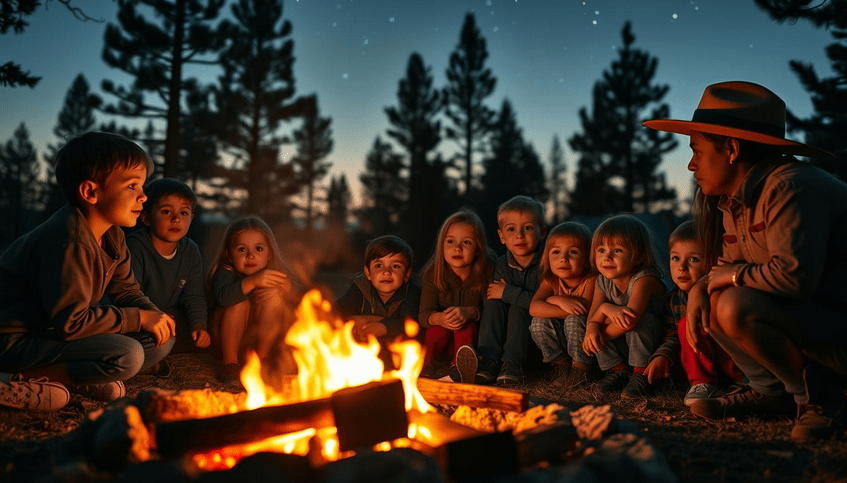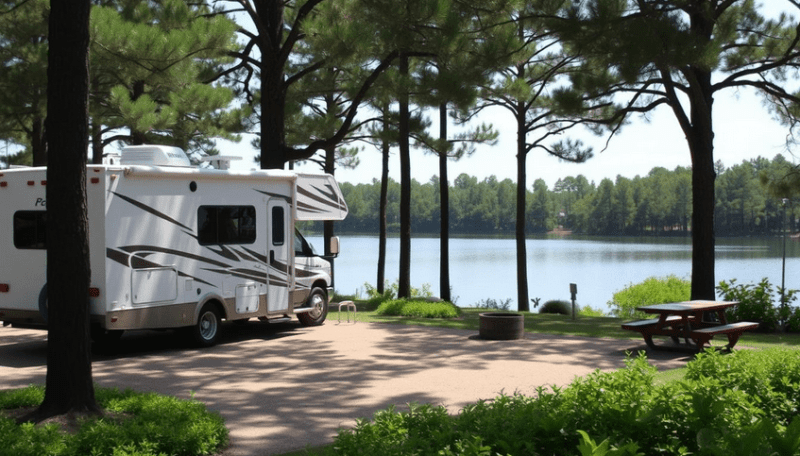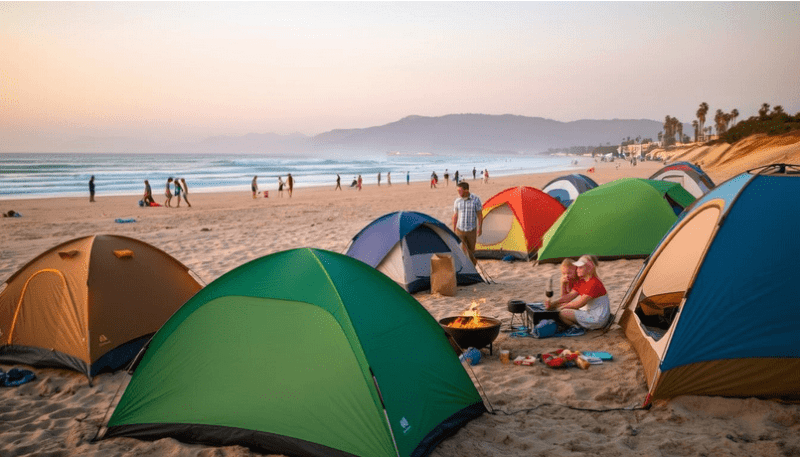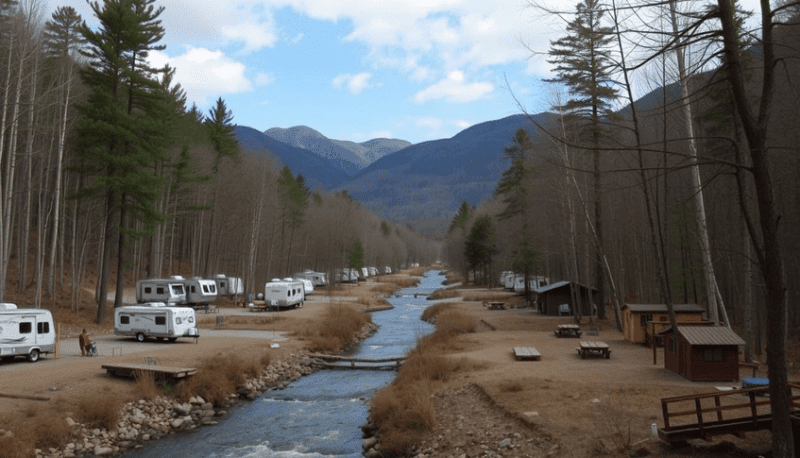Teaching Kids Campfire Safety
Outdoor adventures with family are a great way to create lifelong memories. One essential skill for a successful outdoor experience is knowing how to build a campfire safely.

Having outdoor skills like building a fire is crucial when spending time outside. It requires thought, planning, and time to educate children about the importance of fire safety.
Outdoor safety education is vital for kids to learn how to enjoy nature while minimizing risks. This comprehensive guide will walk you through the steps to ensure your kids are well-equipped with the knowledge they need.
Key Takeaways
- Understand the importance of outdoor safety education for kids.
- Learn how to build a campfire safely.
- Discover ways to educate children about fire safety.
- Find out how to plan a safe outdoor adventure with family.
- Understand the role of adult supervision in campfire safety.
Why Campfire Safety Education Matters for Children
Teaching kids about campfire safety early is key for their safety and others'. Campfire safety lessons are vital for outdoor skills. They help kids in many ways.
The Benefits of Outdoor Fire Experiences
Outdoor fires can be fun and teach kids a lot. They learn about being responsible and following safety rules. A parent said, "Talking and practicing with kids is the best way to teach them about fires. We started when my boys were 2-3 years old."
Understanding Fire Risks and Consequences
It's important for kids to know about fire dangers. They should learn what can happen if they don't follow safety rules. This helps them see why safety is so important.
Age-Appropriate Safety Lessons
Safety lessons for campfires should match the child's age. The way to teach changes with age.
Preschool (Ages 3-5)
Preschoolers need to learn basic safety rules. They should stay away from the fire and not touch it. Simple, clear rules and watching them closely are important.
Elementary (Ages 6-10)
Elementary kids can learn more about fire safety. They can start to understand simple safety rules and why they matter.
Pre-teens and Teens (Ages 11+)
Pre-teens and teens can learn more advanced fire safety. They can learn how to build and maintain a fire safely. They should know how to put out a fire too.
A seasoned outdoor lover said, "The best way to teach kids about campfire safety is to practice and remind them of the rules."
"The greatest reward is seeing your children grow into responsible adults who respect the power of nature."

Preparing for a Safe Campfire Experience
Getting ready for a campfire is key. There are steps to take before you light it. This ensures that everyone, including children, has a safe and enjoyable time.
Selecting the Right Location
Finding the right spot for your campfire is important. Look for a flat, dry area. It should be away from trees, tents, and other things that can catch fire. Make sure it's okay to have a campfire there and follow local rules.
Gathering Proper Equipment and Supplies
Get all the necessary items before starting the fire. You'll need firewood, kindling, a way to start the fire, and water or a fire extinguisher.
Weather Considerations and Fire Restrictions
Check the weather and local fire regulations. Avoid having a campfire on windy days or when the air is dry. Windy days can make embers spread fast, which is dangerous.

Pre-Fire Safety Briefing for Kids
Before starting the fire, discuss safety with the kids. Tell them to stay away from the fire and not touch it. Also, teach them what to do if there's an emergency.
Essential Safety Gear
Ensure you have essential safety items, such as a first aid kit and a fire extinguisher. Teach kids about these tools.
Creating an Emergency Plan
Make a plan with your kids for emergencies. This includes what to do if the fire becomes too large or if someone is injured. Practice the plan so everyone knows what to do.
| Safety Measure | Description | Importance Level |
|---|---|---|
| Selecting the Right Location | Choose a safe, designated area for the campfire. | High |
| Gathering Proper Equipment | Have necessary supplies like firewood and a fire extinguisher. | High |
| Pre-Fire Safety Briefing | Explain safety rules to kids before lighting the campfire. | High |
Teaching Kids Campfire Safety: Step-by-Step Building Process
Campfire safety for kids is more than just avoiding accidents; it's about ensuring their well-being. It's about making outdoor fun safe. Teaching kids how to build a campfire is key for outdoor safety for children. This includes important steps for a fun and safe family experience.
Creating a Proper Fire Pit
First, pick a safe spot for the fire pit. Look for a place with a 10-foot circle clear of branches. This is a big part of kids' camping safety rules.
Collecting and Arranging Firewood Safely
After setting the fire pit, teach kids to collect and arrange firewood safely. They should gather dry wood and stack it for airflow. This is crucial for teaching children about campfire safety.
- Gather dry, sturdy branches.
- Arrange the wood in a teepee shape or a crisscross pattern.
- Leave enough space in the center for air to flow.
Safe Fire Starting Techniques for Kids to Learn
Teaching kids to start a fire safely is very important. Use kid-friendly tools like matches or lighters with safety features. Always watch over kids when they start a fire.
Supervision Requirements by Age Group
The amount of supervision kids need changes with age. Young ones require constant supervision, while older kids can learn more independently.
Demonstration vs. Participation
First, show kids how to build and maintain a safe campfire. As they get more confident, let them help under your watchful eye.
Gradual Responsibility Progression
Give kids more campfire safety tasks as they prove they can handle them. This builds their confidence and skills.
By following these steps and teaching to your kids' age and maturity, you can make camping safe and fun for all. Remember, the goal of teaching children about campfire safety is to let them enjoy the outdoors safely and responsibly.
Essential Campfire Rules and Boundaries for Children
Teaching kids about campfire safety is key for a fun and safe camping trip. Campfires help kids learn about nature and outdoor skills. But, they can be dangerous if not handled right.
Establishing a "Fire Circle" and Safe Distances
It's important to make a safe area around the campfire. Clear the area of things that can catch fire. Then, make a "fire circle" where kids know they must stay unless an adult is with them.
Proper Behavior Around Fire
Teaching children how to behave around campfires is crucial. They should not run or play near the fire. They should not throw things into the fire. And, they must stay seated when near the fire pit.
Handling Sticks, Food, and Cooking Equipment
Teach kids how to handle sticks, food, and cooking tools safely. They should use utensils for cooking. And, they should not touch hot equipment.
Emergency Stop Procedures
It's important to have a plan for emergencies. Kids should know the "stop, drop, and roll" technique.
The "Stop, Drop, and Roll" Technique
This technique helps kids put out flames on their clothes or body in an emergency.
First Aid for Minor Burns
It's also important to know how to treat minor burns. Cool the burn with water. Then, cover it with a non-stick dressing.
| Safety Rule | Description |
|---|---|
| Stay Outside the Fire Circle | Children should stay outside the designated fire circle unless supervised. |
| No Running or Playing Near Fire | Children should avoid running or playing near the campfire to prevent accidents. |
| Use Utensils for Cooking | Children should use utensils when handling food near the campfire. |
Properly Extinguishing Campfires with Kids
Campfire safety is more than just watching the flames go out. It's key to teach kids how to put out campfires right. This helps prevent forest fires and teaches kids to be responsible.
Teaching the "Drown, Stir, Feel" Method
The "drown, stir, feel" method is easy and works well for putting out campfires. First, drown the fire with water, making sure all ashes are wet. Then, stir the ashes to make sure everything is out. Last, feel the ashes with your hand to check for heat. This method is great for kids to learn and fun to do.
"The best way to teach children about fire safety is by making it a fun, interactive experience. By involving them in the process of extinguishing campfires, we can instill in them a lifelong respect for fire."
Explaining Why Complete Extinguishing Is Critical
It's essential to explain to kids why putting out fires completely is crucial. Fires that are not fully extinguished can reignite and cause large forest fires. By understanding this, kids recognize their role in teaching fire safety to others and take it seriously.
| Step | Action | Importance |
|---|---|---|
| Drown | Pour water over the campfire | Soaks ashes, preventing reignition |
| Stir | Mix the ashes to ensure everything is extinguished | Verifies that all embers are out |
| Feel | Check the ashes for any remaining heat | Ensures the fire is completely out |
Making Fire Extinguishing a Regular Responsibility
Make putting out fires a regular part of camping. This way, kids learn to be responsible and see that fire safety is ongoing.
Morning After Safety Check
Do a safety check in the morning to make sure fires are out. This check-up helps kids remember what they learned and can talk about any issues, stressing kids campfire safety tips.
Conclusion: Nurturing Responsible Outdoor Skills
Teaching kids to build and manage a campfire is key. It builds their confidence and sense of responsibility. By following the steps in this article, parents can teach their kids to be safe outdoors.
It's fun to teach kids about campfire safety. Activities like making a "fire circle" and learning to put out fires are great. They learn important outdoor safety skills and feel proud of themselves.
Teaching kids about campfire safety and outdoor skills is rewarding. It helps them appreciate nature and respect fire safety. As they grow, these skills will make their outdoor adventures safer and more enjoyable.
FAQ
What is the most important aspect of teaching kids campfire safety?
The key is to be proactive and plan ahead. Teach kids about campfire safety rules early. This helps prevent accidents.
At what age can children start learning about campfire safety?
Kids can learn about campfire safety as early as preschool. Use lessons that fit their age and understanding.
How can I ensure a safe campfire experience for my kids?
Choose a safe spot for the campfire. Use the right equipment and check the weather. Also, do a safety briefing with your kids before starting the fire.
What are some essential campfire rules to teach children?
Teach kids to stay in a "fire circle." Show them how to act safely around fire. Also, teach them about handling sticks and cooking gear, and what to do in an emergency.
How do I properly extinguish a campfire with kids?
Teach kids the "drown, stir, feel" method to put out the fire. Make sure it's fully out. Make extinguishing the fire a regular task for them.
What should I do in case of a minor burn during a campfire?
If a minor burn happens, teach kids to "stop, drop, and roll." Then, cool the burn with water and cover it with a non-stick dressing.
How can I make teaching campfire safety to kids a fun experience?
Make it fun by using games and activities. Practice starting and stopping fires together. This makes learning fun and hands-on.
What are some additional fire safety tips for kids to know?
Teach kids about fire restrictions and how to handle emergencies. Also, stress the importance of watching campfires closely.
How can I reinforce campfire safety lessons with my kids over time?
Review safety rules often. Practice safety steps together. Make safety a regular part of your camping routine.
DISCLAIMER
This document is provided for general information purposes only and should not be relied upon as providing legal advice, technical, or specific operational guidance to the reader, whether as to the practices described in the document or the applicable legal requirements and regulations. Best Camping Deals.com expressly disclaims any responsibility for liability arising from or related to the use or misuse of any information in this document.



